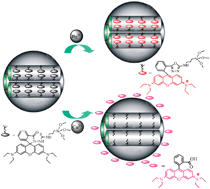The monitoring of Cu2+ levels in living cells has attracted increasing interest, however, the techniques used often suffer from interference from Hg2+. In the present study, we synthesized mesoporous silica nanospheres modified with a rhodamine B derivative containing a thiourea group to be used as a chemodosimeter-functionalized nanoprobe for the detection of Cu2+. This system is expected to offer selective detection of Cu2+ over Hg2+, as these ions react differently with the rhodamine derivative. This chemodosimeter-functionalized nanoprobe was characterized by transmission electron microscopy, small-angle X-ray diffraction, and N2 adsorption–desorption isotherms. The nanoprobe's response to metal cations was investigated using absorption and fluorescence spectroscopies. Addition of Hg2+ or Cu2+ induced a significant solution color change (colorless to purple) and an enhancement in fluorescence of the nanoprobe, even in the presence of other cations in aqueous media. Cu2+-promoted ring-opening and hydrolysis of rhodamine led to the release of rhodamine from the mesoporous nanospheres, while this reaction is not observed in the presence of Hg2+, allowing effective discrimination of these ions through a simple centrifugation treatment. The living cell imaging experiments further demonstrate its value in bioimaging intracellular Cu2+ by virtue of its water solubility, membrane permeability, and nontoxic nature.

You have access to this article
 Please wait while we load your content...
Something went wrong. Try again?
Please wait while we load your content...
Something went wrong. Try again?


 Please wait while we load your content...
Please wait while we load your content...